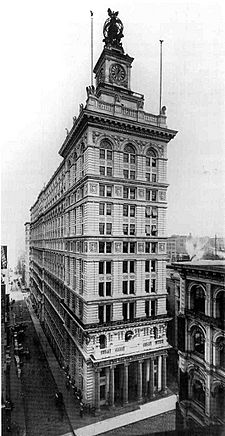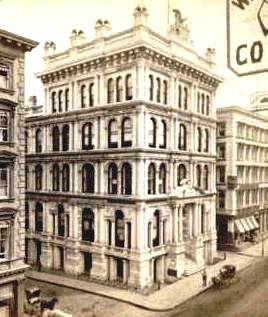Former New York Life Insurance Company Building facts for kids
|
Former New York Life Insurance
Company Building aka Clock Tower Building 346 Broadway |
|

the building after Hatch's and McKim, Mead & White's extension and redesign
|
|
| Location | 346 Broadway, New York, New York |
|---|---|
| Built | 1894 |
| Architect | Stephen D. Hatch; McKim, Mead & White |
| Architectural style | Late 19th And 20th Century Revivals |
| NRHP reference No. | 82003376 |
Quick facts for kids Significant dates |
|
| Added to NRHP | June 28, 1982 |
The Former New York Life Insurance Company Building, also known as the Clock Tower Building, is a famous structure in New York City. It stands at 346 Broadway in the Tribeca area of Manhattan. The building was constructed in two main parts. The first part was built between 1868 and 1870. The second part was added later, from 1894 to 1899.
This historic building is officially recognized as a New York City Landmark. It is also listed on the U.S. National Register of Historic Places. This means it is an important part of the city's and the nation's history.
Contents
The Clock Tower Building's Story
How the Building Grew
The New York Life Insurance Company first built its headquarters here in 1868-1870. Later, the company needed more space. They decided to expand the building towards Lafayette Street.
An architect named Stephen Decatur Hatch was hired for this big job in 1894. Sadly, Hatch passed away before the expansion was finished. The famous architecture firm McKim, Mead & White took over the project. They completed the extension in 1898, following Hatch's original plans.
A New Look and a Grand Clock
After the extension, the company decided to rebuild the original part of the building too. McKim, Mead & White designed a new look for the entire structure. It was built in the Italian Renaissance Revival style, which looks like grand Italian palaces.
The most striking feature was a tall clock tower. The clock itself was made and put in place by the E. Howard Clock Company. It was a very impressive addition to the New York City skyline.
The Missing Atlas Statue
The top of the building's clock tower once had a huge sculpture. It was 33 feet tall and weighed eight tons. The artist, Philip Martiny, created four large figures of Atlas. These figures were shown crouching, holding up a 15-foot-wide hollow globe. On top of the globe was a 7-foot-tall eagle.
This gigantic statue was removed in the late 1940s. No one knows what happened to it, and it has been lost ever since.
A Landmark Building for New York City
The New York Life Insurance Company moved to a new building in 1928. In 1967, the City of New York bought the Clock Tower Building. Various city offices and courts moved into the building.
The building was added to the National Register of Historic Places in 1982. In 1987, its exterior, interior, and the special 1895 E. Howard & Co. No. 4 tower clock mechanism were all named New York City landmarks. This was done by the New York City Landmarks Preservation Commission. The building is also mentioned in the AIA Guide to New York City, which calls the clock a "wonderful Classical clock overlooking Broadway."
Recent Changes and Efforts to Save the Clock
Plans for New Use
In January 2013, the City of New York sold the building. Developers Elad Group and Peebles Corporation bought it for $160 million. They planned to turn the landmark building into a fancy hotel and private apartments.
In 2014, construction began. The clock in the tower stopped working sometime after March 2015. The developers wanted to keep the clock faces but make them electric. They also planned to remove the original 1895 E. Howard clock mechanism. This mechanism is the largest of its kind in the United States and is a protected landmark.
Fighting to Protect the Clock
The New York Landmarks Preservation Commission gave permission for these changes. This meant the clock tower could be closed to the public. It also allowed the developers to remove the historic clock mechanism.
However, many people and groups disagreed with this decision. Groups like Save America's Clock, the Historic Districts Council, and the Tribeca Trust went to court. They wanted to stop the clock tower from becoming private homes. They also wanted to save the historic clock. They argued that the clock tower had always been open to the public. They also pointed out that the clock mechanism itself is a landmark. Since 1979, a special "NYC Clock Master" named Marvin Schneider, and later his assistant, had wound the clock every week.
Court Decisions
On March 31, 2016, a judge ruled in favor of those trying to save the clock. The judge said the Landmarks Preservation Commission could make the building owners keep the mechanical clock. The judge also said the commission could issue a violation if the clock was changed to electric.
The case went to a higher court. On November 30, 2017, that court also ruled against the developers and the City of New York. This decision confirmed that the developers could not make the clock electric or remove it. It also meant they could not close the landmark clock tower to the public. The developers and the City of New York have appealed this decision to an even higher court.
Building Restoration
While the court cases continued, restoration work began on the building's outside. A New York firm cleaned the marble and fixed damaged parts of the roof. They also restored the large, 7,000-pound eagle sculptures on the roof.
Images for kids
See also
 In Spanish: Clock Tower Building para niños
In Spanish: Clock Tower Building para niños



